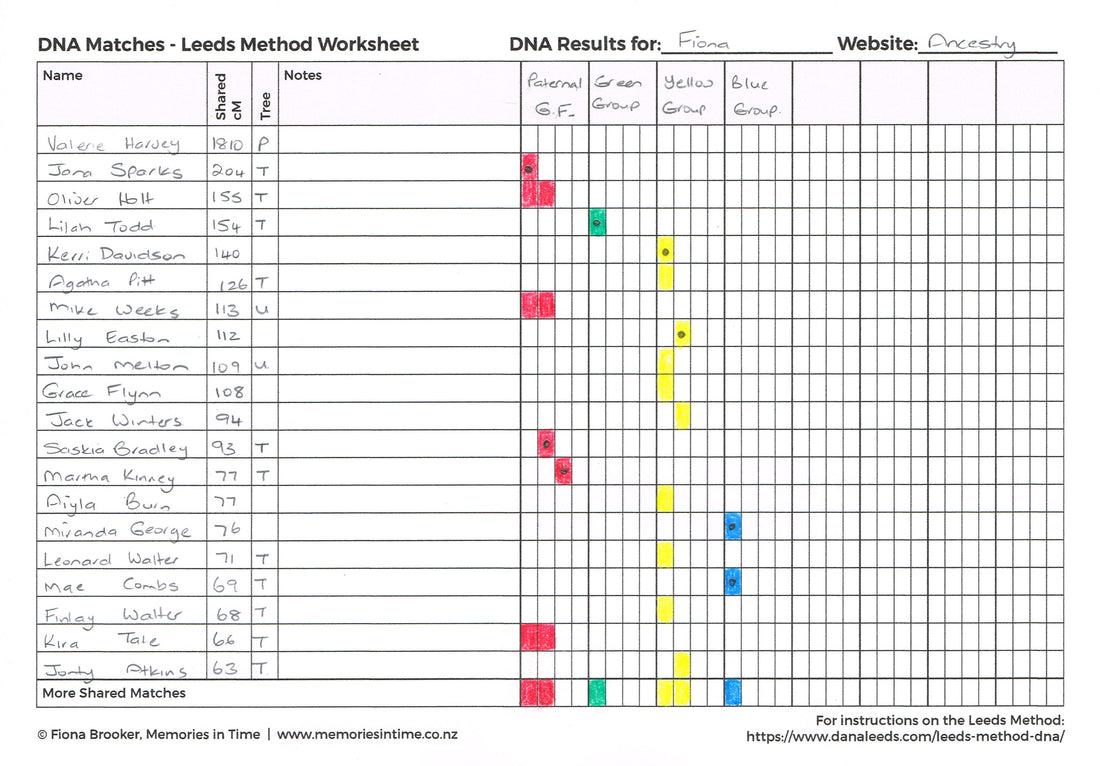The Leeds Method is a way of clustering your DNA matches to try and highlight clusters or groups that match to grandparent lines.
Dana Leeds, who created this method, has some great tutorials on using the method on her website, so make sure you read them.
These tutorials are based on using spreadsheets to work through your matches. If you don’t use spreadsheets then I’ve created some worksheets that you can print off and use for the Leeds Method.

To start with I listed down all the names of my matches (names have been changed to protect privacy) and how many cM’s they shared with me. The column for “Tree” allows me to code them T for tree, P for Private Tree, U for Unlinked Tree and UP for Unlinked Private Tree. If there is no tree I’ve left it blank; maybe in the future a tree will appear.
I would suggest that when you are following this method then just do the next steps without thinking too much about them otherwise you will slip into doing research rather than completing the chart. There is a note column to add any common ancestors information or other information.
So starting with my first match less that 400cM, Jana Sparks, I’ve coloured her red and marked her square with a spot to show that she was the starting point for the column. I then check out their shared matches and colour those red as well. At the bottom of the page there is a row labelled “More Shared Matches” that’s to allow you to note by colouring in the square that there are more matches than are listed on the chart.
Oliver Holt has already been coloured red, so I move to the next row, Lilah Todd and I’ve coloured her green with a spot. She doesn’t have any shared matches in my top 20, but does have additional matches not on the chart.
Next match is Kerri Davidson and I’ve started a new group for her as I recognise one of her matches names and know that they are in a different line of my tree.
The next line without a colour is Lilly Easton and again I recognise her name and colour her yellow along with her matches.
Saskia Bradley is next and when I check her shared matches she also matches to Oliver Holt and so I add her to a new red column. She doesn’t match Jana Sparks, which is just the fluke of the DNA deal.
I’ve corresponded with Martha Kinney before and apart from each other we have no shared matches in Ancestry.
Miranda George seems to be a new set and may possibly be the first match to my Paternal Grandmother.
In my example, I’m lucky in that I recognise some of my closer matches, so I’ve used the colours that I use for my filing (red, blue, yellow, green) for the lines that I know how we are related and for their shared matches. You may end up with more than four colours of matches. Don't panic that just means there are more groups to investigate and that you may have actually identified your great grandparents lines.
Once your chart is completed then you can pick a group to focus on. This may be the group that link to the lines you are currently working on; the group that has the most mysteries or the group that could solve one of your brickwalls. That’s where the second chart comes in and the next blog post.
Download your free DNA Match - Leeds Worksheets from here. The DNA Matches - Leeds Method Worksheet comes in multiple sizes A4/Letter/Legal (20 matches) or A3/Tabloid (50 matches).
Once you've used these worksheets, have a look at our downloadable DNA Match Chart, it's perfect for building matches family trees to try and work our how you're related (and it keeps you organised). Multiple charts for groups of shared matches allow you to spread them out and look for similarities in family trees.
DO YOU WANT SOME HELP
UNDERSTANDING YOUR DNA MATCHES?
I'm happy to have a quick chat with you to see if we I can help you with your DNA results.

If you're ready to dive in then book an
UNDERSTAND YOUR DNA RESULTS WORKSHOP .



1 comment
I’m a Trucker using your worksheets in my downtime to work on parentage for an adoptee. I’m not in the habit of carrying crayons or colored pencils around, so I thought I’d share my workaround. Symbols. So far I’ve used X, *, =, o, ^, + and written them in the legend (gray area) above with the shared surname discovered.
Thanks a lot for an on-the-go, take-anywhere worksheet! ❤️💋❤️💋